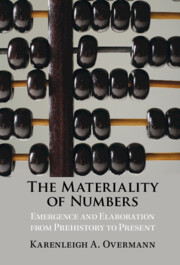Refine search
Actions for selected content:
23990 results in Ancient history
4 - Bodies and Behaviors
-
- Book:
- The Materiality of Numbers
- Published online:
- 11 May 2023
- Print publication:
- 25 May 2023, pp 70-93
-
- Chapter
- Export citation
Copyright page
-
- Book:
- Ancient Greek Housing
- Published online:
- 28 April 2023
- Print publication:
- 25 May 2023, pp iv-iv
-
- Chapter
- Export citation
Chronology
-
- Book:
- Ancient Greek Housing
- Published online:
- 28 April 2023
- Print publication:
- 25 May 2023, pp xix-xx
-
- Chapter
- Export citation
Copyright page
-
- Book:
- The Bacchic Gold Tablets and Poetic Tradition
- Published online:
- 11 May 2023
- Print publication:
- 25 May 2023, pp iv-iv
-
- Chapter
- Export citation
12 - Devices That Accumulate and Group
-
- Book:
- The Materiality of Numbers
- Published online:
- 11 May 2023
- Print publication:
- 25 May 2023, pp 277-308
-
- Chapter
- Export citation
References
-
- Book:
- Ancient Greek Housing
- Published online:
- 28 April 2023
- Print publication:
- 25 May 2023, pp 296-321
-
- Chapter
- Export citation

The Materiality of Numbers
- Emergence and Elaboration from Prehistory to Present
-
- Published online:
- 11 May 2023
- Print publication:
- 25 May 2023

The Bacchic Gold Tablets and Poetic Tradition
- Memory and Performance
-
- Published online:
- 11 May 2023
- Print publication:
- 25 May 2023
Conclusions
-
- Book:
- The Field Armies of the East Roman Empire, 361–630
- Published online:
- 27 April 2023
- Print publication:
- 11 May 2023, pp 92-104
-
- Chapter
- Export citation
Chapter 10 - Sulla’s Dictatorship Rei Publicae Constituendae and Roman Republican Cultural Memory
- from Part II - Politicising Cultural Memory
-
-
- Book:
- Cultural Memory in Republican and Augustan Rome
- Published online:
- 27 April 2023
- Print publication:
- 11 May 2023, pp 169-182
-
- Chapter
- Export citation
Index
-
- Book:
- Cultural Memory in Republican and Augustan Rome
- Published online:
- 27 April 2023
- Print publication:
- 11 May 2023, pp 472-476
-
- Chapter
- Export citation
Contents
-
- Book:
- The Field Armies of the East Roman Empire, 361–630
- Published online:
- 27 April 2023
- Print publication:
- 11 May 2023, pp v-vi
-
- Chapter
- Export citation
Chapter 1 - Introduction: What is Cultural Memory?
-
-
- Book:
- Cultural Memory in Republican and Augustan Rome
- Published online:
- 27 April 2023
- Print publication:
- 11 May 2023, pp 1-20
-
- Chapter
- Export citation
Abbreviations
-
- Book:
- The Field Armies of the East Roman Empire, 361–630
- Published online:
- 27 April 2023
- Print publication:
- 11 May 2023, pp xvi-xvii
-
- Chapter
- Export citation
Chapter 20 - Cicero and Clodius Together: The Porta Romana Inscriptions of Roman Ostia As Cultural Memory
- from Part IV - Locating Cultural Memory
-
-
- Book:
- Cultural Memory in Republican and Augustan Rome
- Published online:
- 27 April 2023
- Print publication:
- 11 May 2023, pp 355-374
-
- Chapter
- Export citation
Chapter 19 - Exchanging Memories: Coins, Conquest, and Resistance in Roman Iberia
- from Part IV - Locating Cultural Memory
-
-
- Book:
- Cultural Memory in Republican and Augustan Rome
- Published online:
- 27 April 2023
- Print publication:
- 11 May 2023, pp 333-354
-
- Chapter
- Export citation
Appendix 1 - The Roman High Command at Adrianople (378)
-
- Book:
- The Field Armies of the East Roman Empire, 361–630
- Published online:
- 27 April 2023
- Print publication:
- 11 May 2023, pp 105-112
-
- Chapter
- Export citation
Appendix 3 - A Revised Fasti of the Eastern Praesental Generals (MMPs)
-
- Book:
- The Field Armies of the East Roman Empire, 361–630
- Published online:
- 27 April 2023
- Print publication:
- 11 May 2023, pp 127-151
-
- Chapter
- Export citation
Preface
-
- Book:
- The Field Armies of the East Roman Empire, 361–630
- Published online:
- 27 April 2023
- Print publication:
- 11 May 2023, pp vii-xv
-
- Chapter
- Export citation
Bibliography
-
- Book:
- Cultural Memory in Republican and Augustan Rome
- Published online:
- 27 April 2023
- Print publication:
- 11 May 2023, pp 413-465
-
- Chapter
- Export citation
